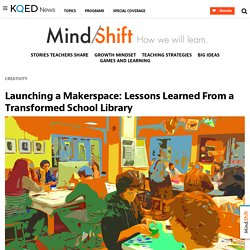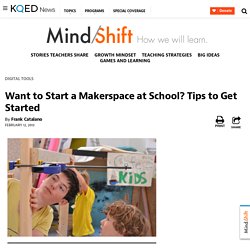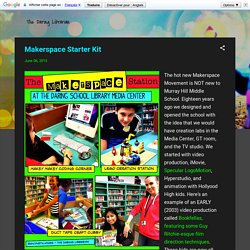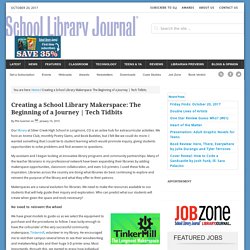

How a School Library Increased Student Use by 1,000 Percent. Launching a Makerspace: Lessons Learned From a Transformed School Library. Excitement about school makerspaces has been in the air, but many educators eager to create hands-on learning spaces in their schools still aren’t sure how to get started or why it’s worth the effort.

New Canaan High School librarian Michelle Luhtala recently jumped headfirst into creating a makerspace in her library and documented what she learned, how her space changed and how it affected students along the way. Her experience was very different from elementary school librarian Andy Plemmons, whose makerspace started with a 3-D printer obtained through a grant and blossomed into a core teaching resource at his school. Luhtala is blessed with a big library, but for most of her career it has been dominated by large bookshelves. Over time, Luhtala has pared down her collection as she increased the digital reading material the library offers, but in order to make room for a makerspace she cleared out 7,000 books. A floor plan of shelving in Luhtala’s library in 2011. How We Built Our School Makerspace. Want to Start a Makerspace at School? Tips to Get Started. As the Maker Movement starts to gain momentum, schools that are trying to find ways to foster the do-it-yourself environment can learn a few lessons from another nexus in the universe: public libraries.

Dale Dougherty, founding editor and publisher of Make Magazine — and the de facto leader of the Maker Movement — has a vision to create a network of libraries, museums, and schools with what he calls “makerspaces” that draw on common resources and experts in each community. Libraries and museums, he said, are easier places to incorporate makerspaces than schools, because they have more space flexibility and they’re trying to attract teens with their programs. “Schools have already got the kids,” Dougherty noted wryly, at the recent American Library Association Midwinter Meeting in Seattle.
One day during the conference, dubbed Maker Monday, focused on the Maker Movement, which emphasizes learning by engaging in tech-related projects. “Why are you here?” Makerspace Starter Kit. The hot new Makerspace Movement is NOT new to Murray Hill Middle School.

Eighteen years ago we designed and opened the school with the idea that we would have creation labs in the Media Center, GT room, and the TV studio. We started with video production, iMovie, Specular LogoMotion, Hyperstudio, and animation with Hollyood High kids. Here's an example of an EARLY (2003) video production called Bookfellas, featuring some Guy Ritchie-esque film direction techniques. These kids are now all grown up and we've kept evolving, too! It's OK to Start Small! I re-purposed some of my empty study carrels for this Makerspace center at the top corner of our library. As I asserted in a recent blog post about new Ed Tech trends, fads, & tech -you can start small and You Don't Have to Marry It! For the Duct Tape Craft Cubby, I used a spring loaded curtain rod to hold the duct tape rolls, bought a bright blue colored shower caddy for the scissors and other tools.
Creating a School Library Makerspace: The Beginning of a Journey. Our library at Silver Creek High School in Longmont, CO is an active hub for extracurricular activities.

We host an Anime Club, monthly Poetry Slams, and Book Buddies, but I felt like we could do more. I wanted something that I could tie to student learning which would promote inquiry, giving students opportunities to solve problems and find answers to questions. My assistant and I began looking at innovative library programs and community partnerships. Many of the teacher librarians in my professional network have been expanding their libraries by adding makerspace opportunities, classroom collaboration, and even 3-D printers.
I used these folks as inspiration. Makerspaces are a natural evolution for libraries. No need to reinvent the wheel We have great models to guide us as we select the equipment to purchase and the procedures to follow. Where to get the money? Next steps This week we will receive our first purchases. Create a school makerspace in 3 simple steps. As maker education gains steam, many educators are looking for ways to incorporate making and tinkering into their schools and classrooms — often on a shoestring budget. “Kids are saying they want to learn more about technology and science, but they also want to experience it creatively and use it personally,” said Dale Dougherty, founder of Make Media, which produces Maker Faire and Make Magazine. He’ll address how educators can deliver these types of experimental learning experiences during ISTE 2014’s EdTekTalks, a provocative series of mini-keynotes from thought leaders beyond the world of ed tech.
“One of the ways we can do that is create more makerspaces for kids. Part of my talk will be leading the charge to say let’s build more makerspaces inside schools, libraries and even community centers.” But what makes a makerspace? Makerspaces can be elaborate learning spaces equipped with sophisticated tools and supplies, but they don’t have to be. Step 1: Secure some space. Starting a School Makerspace from Scratch. With the National Week of Making behind us, you might be ready to start a makerspace in your school -- but not know where to start.
Will purchasing a costly 3D printer and the latest robotics kit ensure learning and maker success? What are some steps to starting a successful makerspace from scratch? Step 1: Immerse Yourself in Maker Education Before you can build your own community of makers, you need to join one! Immerse yourself in makerspaces by joining a summer maker camp like Exploratorium's Tinkering Fundamentals or the virtual Camp Google for cheap and easy STEM ideas, but most importantly: make stuff! Step 2: Get Others Involved Start a steering committee for your makerspace by involving interested teachers and students.